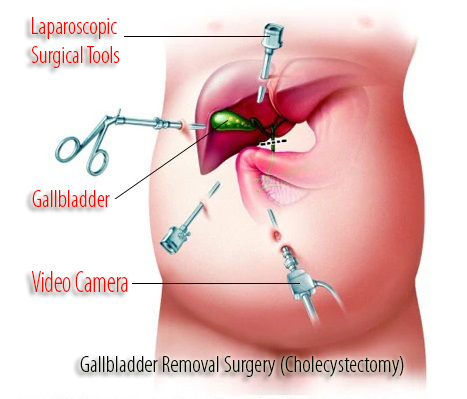Cholecystectomy is the process to remove gallbladder by surgery. It is a very common procedure. Cholecystectomy is a standard treatment of indicative gallstones and other gallbladder conditions.
The gallbladder is a small, pouch-like organ in the upper right part of your abdomen. It collects bile, a fluid produced by the liver that helps break down fatty meals.
There will be no harm even if you remove it. If you develop any problem doctors recommend to remove gallbladder.

Why does gallbladder need to be removed?
Operation to remove the gallbladder is usually carried out if you have disturbing gallstones. These are tiny stones that can form in the gallbladder as a result of a disproportion in the things that make up bile.
Gallstones often cause no signs and you may not realize you have them, but seldom they can block the flow of bile and annoy the gallbladder (acute cholecystitis) or pancreas (acute pancreatitis).
Gallbladder can generate signs such as:
- Sudden and intense stomach ache
- Feeling and being sick
- Yellowing of the skin and the whites of the eyes (jaundice)
Gallbladder Treatment
Very hardly it may be possible to take medicines to melt gallstones, but operation to remove the gallbladder is the most powerful treatment in the majority of cases.
There are two main processes of removing a gallbladder:
Laparoscopic (keyhole) cholecystectomy
Many small cuts (incisions) are made in your tummy (abdomen) and fine surgical tools are used to access and remove your gallbladder
Open cholecystectomy
A single, larger cut is made in your tummy to reach and remove your gallbladder. Keyhole surgery is used most often because you can leave the hospital soon, recover faster and are left with smaller wounds than with an open procedure. Both procedures are performed under general anesthetic, which means you’ll be asleep during the operation and won’t feel any pain while it’s carried out.
Recovering from gallbladder removal surgery
It doesn’t take long to heal from keyhole surgery to remove your gallbladder.
Maximum people can leave the hospital the same day or the next morning. They can return to most of the normal activities within two weeks.
It takes longer to heal from open surgery. People may need to stay in hospital for three to five days and it could be six to eight weeks before feeling back to normal.
Living without a gallbladder
You can start a perfectly normal life without a gallbladder.
Your liver will still make plenty of bile to digest the food but instead of being stored in the gallbladder, it drips continuously into your digestive system.
You may have been advised to eat a special diet before surgery, but this doesn’t need to be continued afterward. Rather, you should try to have an ordinarily healthy, balanced diet.
Some people feel problems such as bloating or diarrhoea after surgery, although this normally improves within a few weeks. If you notice specific foods or drinks trigger these signs, you should avoid them in the future.
Risks of gallbladder removal surgery
Gallbladder removal surgery is considered to be a safe method, but like any type of surgery, there is a risk of complications.
Possible complications include:
· wound infection
· bile leaking into the tummy
· damage to one of the holes (pipes) carrying bile out of the liver
· blood clots

